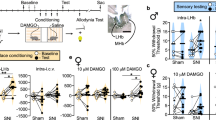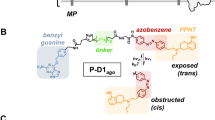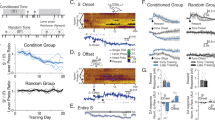Abstract
Photoactivatable drugs and peptides can drive quantitative studies into receptor signaling with high spatiotemporal precision, yet few are compatible with behavioral studies in mammals. We developed CNV-Y-DAMGO—a caged derivative of the mu opioid receptor-selective peptide agonist DAMGO. Photoactivation in the mouse ventral tegmental area produced an opioid-dependent increase in locomotion within seconds of illumination. These results demonstrate the power of in vivo photopharmacology for dynamic studies into animal behavior.
This is a preview of subscription content, access via your institution
Access options
Access Nature and 54 other Nature Portfolio journals
Get Nature+, our best-value online-access subscription
$29.99 / 30 days
cancel any time
Subscribe to this journal
Receive 12 print issues and online access
$259.00 per year
only $21.58 per issue
Buy this article
- Purchase on Springer Link
- Instant access to full article PDF
Prices may be subject to local taxes which are calculated during checkout


Similar content being viewed by others
Data availability
The data supporting the findings of this study are available within the paper and its Extended Data files. Source data are provided with this paper.
References
Ellis-Davies, G. C. R. Caged compounds: photorelease technology for control of cellular chemistry and physiology. Nat. Methods 4, 619–628 (2007).
Paoletti, P., Ellis-Davies, G. C. R. & Mourot, A. Optical control of neuronal ion channels and receptors. Nat. Rev. Neurosci. 20, 514–532 (2019).
Ankenbruck, N., Courtney, T., Naro, Y. & Deiters, A. Optochemical control of biological processes in cells and animals. Angew. Chem. Int. Ed. Engl. 57, 2768–2798 (2018).
Font, J. et al. Optical control of pain in vivo with a photoactive mGlu5 receptor negative allosteric modulator. eLife 6, e23545 (2017).
López-Cano, M. et al. Remote local photoactivation of morphine produces analgesia without opioid-related adverse effects. Br. J. Pharmacol. https://doi.org/10.1111/bph.15645 (2021).
Cuttoli, R. D. De et al. Optofluidic control of rodent learning using cloaked caged glutamate. Proc. Natl Acad. Sci. USA 117, 6831–6835 (2020).
Taura, J. et al. Remote control of movement disorders using a photoactive adenosine A 2A receptor antagonist. J. Control. Release 283, 135–142 (2018).
Noguchi, J. et al. In vivo two-photon uncaging of glutamate revealing the structure-function relationships of dendritic spines in the neocortex of adult mice. J. Physiol. 589, 2447–2457 (2011).
Gomes, I. et al. Biased signaling by endogenous opioid peptides. Proc. Natl Acad. Sci. USA 117, 11820–11828 (2020).
Banghart, M. R. & Sabatini, B. L. Photoactivatable neuropeptides for spatiotemporally precise delivery of opioids in neural tissue. Neuron 73, 249–259 (2012).
Banghart, M. R., He, X. J. & Sabatini, B. L. A caged enkephalin optimized for simultaneously probing mu and delta opioid receptors. ACS Chem. Neurosci. 9, 684–690 (2018).
Craves, F. B., Law, P. Y., Hunt, C. A. & Loh, H. H. The metabolic disposition of radiolabeled enkephalins in vitro and in situ. J. Pharmacol. Exp. Ther. 206, 492–506 (1978).
Handa, B. K. et al. Analogues of β-LPH61-64 possessing selective agonist activity at μ-opiate receptors. Eur. J. Pharmacol. 70, 531–540 (1981).
He, X. J. et al. Convergent, functionally independent signaling by mu and delta opioid receptors in hippocampal parvalbumin interneurons. eLife 10, e69746 (2021).
Castro, D. C. et al. An endogenous opioid circuit determines state-dependent reward consumption. Nature 598, 646–651 (2021).
Manning, B. H., Morgan, M. J. & Franklin, K. B. J. Morphine analgesia in the formalin test: evidence for forebrain and midbrain sites of action. Neuroscience 63, 289–294 (1994).
Johnson, S. W. & North, R. A. Opioids excite dopamine neurons by hyperpolarization of local interneurons. J. Neurosci. 12, 483–488 (1992).
Joyce, E. M. & Iversen, S. D. The effect of morphine applied locally to mesencephalic dopamine cell bodies on spontaneous motor activity in the rat. Neurosci. Lett. 14, 207–212 (1979).
Hüll, K., Morstein, J. & Trauner, D. In vivo photopharmacology. Chem. Rev. 118, 10710–10747 (2018).
Tochitsky, I., Kienzler, M. A., Isacoff, E. & Kramer, R. H. Restoring vision to the blind with chemical photoswitches. Chem. Rev. 118, 10748–10773 (2018).
Gomila, A. M. J. et al. Photocontrol of endogenous glycine receptors in vivo. Cell Chem. Biol. 27, 1425–1433.e7 (2020).
Donthamsetti, P. et al. Cell specific photoswitchable agonist for reversible control of endogenous dopamine receptors. Nat. Commun. 12, 4775 (2021).
Acosta-Ruiz, A. et al. Branched photoswitchable tethered ligands enable ultra-efficient optical control and detection of G protein-coupled receptors in vivo. Neuron 105, 446–463.e13 (2020).
Davenport, C. M. et al. Relocation of an extrasynaptic GABAA receptor to inhibitory synapses freezes excitatory synaptic strength and preserves memory. Neuron 109, 123–134.e4 (2021).
Zhang, Y. et al. Battery-free, lightweight, injectable microsystem for in vivo wireless pharmacology and optogenetics. Proc. Natl Acad. Sci. USA 116, 21427–21437 (2019).
Frank, J. A. et al. In vivo photopharmacology enabled by multifunctional fibers. ACS Chem. Neurosci. 11, 3802–3813 (2020).
Gilbert, D. et al. Caged capsaicins: new tools for the examination of TRPV1 channels in somatosensory neurons. ChemBioChem 8, 89–97 (2007).
Tanowitz, M. & von Zastrow, M. A novel endocytic recycling signal that distinguishes the membrane trafficking of naturally occurring opioid receptors. J. Biol. Chem. 278, 45978–45986 (2003).
Pologruto, T. A., Sabatini, B. L. & Svoboda, K. ScanImage: flexible software for operating laser scanning microscopes. Biomed. Eng. Online 2, 13 (2003).
Acknowledgements
We thank E. Berg for technical support, J. Isaacson for helpful discussions and J. Chang-Weinberg for manuscript editing. This work was supported by the National Institute of Neurological Disorders and Stroke and the National Institute of Mental Health (U01NS113295 to M.R.B., including Diversity Supplements to D.A.J. and A.E.L.), the National Institute of General Medical Sciences (R35GM133802 to M.R.B., T32GM007240 to X.J.H.), the Brain and Behavior Research Foundation (M.R.B.), the Esther A. and Joseph Klingenstein Fund and Simons Foundation (M.R.B.), the Rita Allen Foundation (M.R.B.) and by Plan Nacional Sobre Drogas (Spanish Ministerio de Sandidad, 2021I070 to J.B.).
Author information
Authors and Affiliations
Contributions
X.M., D.A.J., X.J.H. and M.R.B. designed research. X.M., D.A.J., A.E.L., X.J.H., S.P.M., J.C.Y., A.R. and J.B. performed research. X.M. contributed new reagents or analytical tools. X.M., D.A.J., X.J.H. and M.R.B. analyzed data. M.R.B., X.M. and D.A.J. wrote the paper.
Corresponding author
Ethics declarations
Competing interests
The authors declare no competing interests.
Peer review
Peer review information
Nature Methods thanks James Frank and the other, anonymous, reviewer(s) for their contribution to the peer review of this work. Peer reviewer reports are available. Primary Handling Editor: Nina Vogt, in collaboration with the Nature Methods team.
Additional information
Publisher’s note Springer Nature remains neutral with regard to jurisdictional claims in published maps and institutional affiliations.
Extended data
Extended Data Fig. 1 Synthesis of CNV-Y-DAMGO (4).
The N-terminal amine in DAMGO (3) was Boc-protected prior to phenol alkylation with 6. Global deprotection with TFA produced CNV-Y-DAMGO (4) in good overall yield.
Extended Data Fig. 2 In vitro characterization of CNV-Y-DAMGO activity at opioid receptors.
(A) Dose-response curves at the delta opioid receptor (DOR) using a GloSensor assay of cAMP signaling in HEK293T cells (n = 5 wells per data point, 1 representative independent experiment shown). Data were normalized to the maximal response to leucine-enkephalin (LE, 1 µM) and are expressed as the mean ± SEM. (B) Same as A, but using the kappa opioid receptor (KOR) and dynorphin A(1-8) (Dyn8, 1 µM) for normalization. (C) Same as A, but using the nociceptin/orphanin FQ receptor (NOP) and nociception/orphanin FQ (N/OFQ, 1 µM) for normalization. (D) Dose-response curves at the mu opioid receptor (MOR) using a NanoBiT-based luminescence complementation assay of β-arrestin signaling in HEK293T cells (n = 4 wells per data point, 3 independent experiments averaged). Data were normalized to the maximal response to DAMGO (10 µM) and are expressed as the mean ± SEM.
Extended Data Fig. 3 In vitro characterization of CNV-Y-DAMGO (4) photolysis and dark stability.
(A) Waterfall plot of HPLC chromatograms of CNV-Y-DAMGO (0.4 mM) during illumination with 375 nm light (10 mW) in PBS, pH 7.2. (B) Enlarged HPLC chromatogram after 2 min of illumination (top) and mass spectrograms corresponding to the indicated peaks (bottom). (C) HPLC chromatograms of a sample of CNV-Y-DAMGO (1 mM) in PBS left for 24 hours in the dark. (D) Summary of MNI-Glutamate and CNV-Y-DAMGO photouncaging reactions over time, as measured by HPLC (n = 3 samples per condition). Samples were optical density-matched at 375 nm in PBS and illuminated with 375 nm laser irradiation. Data are expressed as the mean ± SEM. (E) UV-VIS spectrum of samples of CNV-Y-DAMGO (0.4 mM) in PBS before and after irradiation with 375 nm light (10 mW) for the indicated time periods.
Extended Data Fig. 4 DAMGO infusion into the VTA and location of optofluidic cannula placements.
(A) Schematic of the experimental configuration for DAMGO infusion through an optofluidic cannula. (B) Experimental timeline. (C) Movement velocity vs. time in the open field for a cohort of mice after DAMGO (200 µM, 0.5 uL) infusion. (D) Average data from C (n = 6 mice). Data are expressed as the mean ± SEM. (E) Example maps of open field locomotor activity from a single mouse after infusion of either saline or DAMGO. (F) Change in distance traveled (after-before uncaging) mapped to the implant location for the mice shown in Fig. 2g,h.
Supplementary information
Representative formalin-treated mouse infused with CNV-Y-DAMGO in the NAc and exposed to light: minutes 29–31 postinjection.
Representative formalin-treated control mouse exposed to light: minutes 29–31 postinjection.
Representative mouse infused with CNV-Y-DAMGO in the VTA and exposed to light.
Representative mouse infused with CNV-Y-DAMGO in the VTA and exposed to light after treatment with naloxone.
Source data
Source Data Fig. 1
Statistical source data.
Source Data Fig. 2
Statistical source data.
Source Data Extended Data Fig. 2
Statistical source data.
Source Data Extended Data Fig. 3
Statistical source data.
Source Data Extended Data Fig. 4
Statistical source data.
Rights and permissions
Springer Nature or its licensor (e.g. a society or other partner) holds exclusive rights to this article under a publishing agreement with the author(s) or other rightsholder(s); author self-archiving of the accepted manuscript version of this article is solely governed by the terms of such publishing agreement and applicable law.
About this article
Cite this article
Ma, X., Johnson, D.A., He, X.J. et al. In vivo photopharmacology with a caged mu opioid receptor agonist drives rapid changes in behavior. Nat Methods 20, 682–685 (2023). https://doi.org/10.1038/s41592-023-01819-w
Received:
Accepted:
Published:
Issue Date:
DOI: https://doi.org/10.1038/s41592-023-01819-w
This article is cited by
-
Human OPRM1 and murine Oprm1 promoter driven viral constructs for genetic access to μ-opioidergic cell types
Nature Communications (2023)



